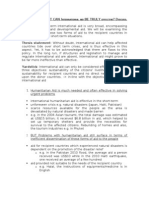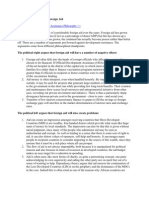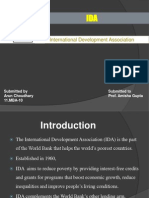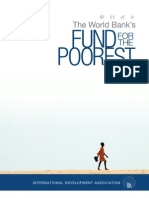0 ratings0% found this document useful (0 votes)
8 viewsDevelopment Aid
Development Aid
Uploaded by
AAC TjoaConditional aid comes with requirements that the recipient country purchase goods from the donor country. While this benefits the donor's economy, it may lead projects that are not appropriate or do not benefit local people. Multilateral aid is allocated through international organizations but still requires repayment as loans. NGOs implement small, community-based projects but rely on public donations that may fluctuate. A key disadvantage of all aid is that it can create dependency of developing countries on external assistance.
Copyright:
© All Rights Reserved
Available Formats
Download as PPTX, PDF, TXT or read online from Scribd
Development Aid
Development Aid
Uploaded by
AAC Tjoa0 ratings0% found this document useful (0 votes)
8 views16 pagesConditional aid comes with requirements that the recipient country purchase goods from the donor country. While this benefits the donor's economy, it may lead projects that are not appropriate or do not benefit local people. Multilateral aid is allocated through international organizations but still requires repayment as loans. NGOs implement small, community-based projects but rely on public donations that may fluctuate. A key disadvantage of all aid is that it can create dependency of developing countries on external assistance.
Original Title
Development Aid.pptx
Copyright
© © All Rights Reserved
Available Formats
PPTX, PDF, TXT or read online from Scribd
Share this document
Did you find this document useful?
Is this content inappropriate?
Conditional aid comes with requirements that the recipient country purchase goods from the donor country. While this benefits the donor's economy, it may lead projects that are not appropriate or do not benefit local people. Multilateral aid is allocated through international organizations but still requires repayment as loans. NGOs implement small, community-based projects but rely on public donations that may fluctuate. A key disadvantage of all aid is that it can create dependency of developing countries on external assistance.
Copyright:
© All Rights Reserved
Available Formats
Download as PPTX, PDF, TXT or read online from Scribd
Download as pptx, pdf, or txt
0 ratings0% found this document useful (0 votes)
8 views16 pagesDevelopment Aid
Development Aid
Uploaded by
AAC TjoaConditional aid comes with requirements that the recipient country purchase goods from the donor country. While this benefits the donor's economy, it may lead projects that are not appropriate or do not benefit local people. Multilateral aid is allocated through international organizations but still requires repayment as loans. NGOs implement small, community-based projects but rely on public donations that may fluctuate. A key disadvantage of all aid is that it can create dependency of developing countries on external assistance.
Copyright:
© All Rights Reserved
Available Formats
Download as PPTX, PDF, TXT or read online from Scribd
Download as pptx, pdf, or txt
You are on page 1of 16
BANTUAN DAN
PINJAMAN
PEMBANGUNAN
(DEVELOPMENT
AID)
TEKNIK GEODESI DAN
GEOMATIKA
INSTITUT TEKNOLOGI BANDUNG
APAKAH BANTUAN/PINJAMAN
ITU?
Aid is given by donor countries to recipient countries to help their
development,or help them recover from a natural disaster.
The aid takes many forms and can be given on a large scale or small scale.
Large scale aid is called top-down aid as it is usually given to the
government of the developing country so that they can spend it on the
projects that they need.
Unfortunately this can lead to the mis-use of aid money by unscrupulous
governments. Aid from developing country governments tends to be given
as top-down aid.
Small scale aid projects are called bottom-up aid. These target the people
most in need of the aid and help them directly, without any government
interference. Aid from charities tends to be bottom-up aid.
There are five main types of aid that can be given to developing countries
BANTUAN/PINJAMAN
BERSYARAT
Conditional aid is given by a donor country (MEDC) to a
receptor country (LEDC) to finance projects in that country. In
return the receptor country usually has to agree to buy other
products from the from the donor country
A good example was the building of the Aswan dam in
Egypt. The Russians gave the Egyptians money to help build
the dam, in return for Egypt allowing them unlimited access to
its airfields.
The project began in the 1950's and General Nassua eventually
told the Russians to leave after the six day war in 1967.
BANTUAN/PINJAMAN
BERSYARAT
In 1994 the British Government came under fire as
details of a supposed conditional aid package reached
the public. The scheme involved Britain giving £234
million worth of aid to help the Malaysian Government
build their Pergauhydro-electric dam scheme.
However it then emerged that this aid was linked to
£1.3 billion of British defence contracts with Malaysia.
Similar claims were made about defence contracts and
aid money given to Indonesia.
BANTUAN/PINJAMAN JANGKA
PANJANG
Long-term Aid: Long term aid aims to help the country
develop in the future, by introducing schemes to help things
like health care, education and food production. Many of the
NGO's are involved in these long term schemes, which can be
large scale or small scale projects.
The main aim of the schemes is to introduce ideas and thinking
that can be easily sustained by the local community, with only
the help of the NGO to set them up in the first place.
Many of the schemes introduced by Comic Relief into countries
like Burkina Faso and Ethiopia are examples of long term
sustainable aid.
BANTUAN/PINJAMAN JANGKA
PENDEK
Short-term Aid: Also known as emergency aid, this is the
aid that you will have seen on the news. Charities and
governments send short term aid after a natural disaster to
help the country recover.
Two recent examples include the famines in Africa for which
food, medicine and shelters were quickly sent over to countries
such as Ethiopia and Sudan. Then there were the terrible floods
in Mozambique in early 2000, which led to food, medicine,
clothes and shelters being sent over, as well as South African
helicopters being used to pluck people from the flood waters.
BANTUAN/PINJAMAN
MULTILATERAL
Multilateral Aid: This form of aid involves the developed
countries giving money to central international
organisations such as the World Bank and the World
Health Organisation. These then decide where and when
the money is going to be spent. In the case of the World
Bank this money is still a loan, that will need to be paid
back, whilst other organisations act more like charities.
It is this form of aid that the Brandt Report suggested each
country should give 0.7% of its GNP towards. However
most countries do not get close to reaching that target.
BANTUAN/PINJAMAN BILATERAL
DAN BANTUAN/PINJAMAN TERIKAT
Memiliki definisi yang sama dengan
bantuan/pinjaman bersyarat
Lihat “Bantuan/Pinjaman Bersyarat”
Note: Bilateral aid, from one country to another, is
frequently criticised because it often seems to
serve the interests of the donor nation as much as,
if not more than, the country receiving aid.
(Pencitraan doang)
Non Governmental Organisation
The term non-governmental organisation (NGO) came into common
usage in 1945 when the United Nations used it in its Charter to
distinguish between intergovernmental agencies and international
private organisations (NGOs).
Some 25,000 organisations, covering a huge variety of objectives, now
qualify as international NGOs. The influence of NGOs on international
policy has increased markedly in the last few decades. They have
successfully promoted:
• new environmental agreements
• women’s rights
• arms control and disarmament measures
• the rights of children, the disabled, the poor and indigenous peoples.
DARIMANA NGO MENDAPATKAN
UANG?
NGOs are usually financed from the following
sources:
membership dues – the traditional source of
funding
government grants
retail operations, eg charity shops
private foundations, corporations and wealthy
individuals.
Types Advantages: Disadvantages:
The recipient country gets the money The recipient country falls further into
Advantage & Disadvantage
Conditional Aid:
it needs for projects that will benefit
the country. The donor country keeps
an "economic colonial" hold over the
debt to the donor country. The projects
are often large scale, where it would
actually benefit the ordinary people
recipient country. The donor country more by using small scale community
increases its trade and economic schemes. The projects are often not
influence. appropriate for the recipient country.
Theoretically the aid comes with no
The aid is still a loan that must be paid
ties to the donor country as it is
back, along with the interest charges on
allocated by international
Multilateral Aid: it. The aid often does not reach the
organisations. The real needs of the
people it was meant for as the
recipient country are focussed on for
government uses it for other purposes.
the aid to be targeted towards.
They work on smaller community-
based projects that help the people They rely on the generosity of the public
who most need it. There are no as well as donations from governments
NGO’s(charities):
political ties. The projects use for their funds. This means that their
technology appropriate to the area that cash flow isn?t always guaranteed.
they are in.
KETIDAKUNTUNGAN
The main disadvantage of all forms of aid is that
many developing countries have become dependent
upon it for their survival.
This has led to some developing countries calling aid
an "economic colonialism" where the developed
countries have a tight hold over the development of
the developing countries. The massive debts that
many of them have only increase this dependency on
aid form the developed countries.
You might also like
- Development AidDocument16 pagesDevelopment AidFadillah Rizqi Prayoga PrayogaNo ratings yet
- To Fix Foreign Aid, Pay The Poor Directly: ArgumentDocument5 pagesTo Fix Foreign Aid, Pay The Poor Directly: ArgumentanafranciscomnfNo ratings yet
- Paper 4 Advanced Human Geography Options - Key TermsDocument2 pagesPaper 4 Advanced Human Geography Options - Key Termsbuloow127No ratings yet
- Aid TerminologyDocument2 pagesAid TerminologyJimin SonNo ratings yet
- Compiled Notes For Finals. Weeks 9-12,13 and 15. IPEDocument46 pagesCompiled Notes For Finals. Weeks 9-12,13 and 15. IPEPatrick RamosNo ratings yet
- Pros of Foreign AidDocument3 pagesPros of Foreign AidRokaia MortadaNo ratings yet
- CR_GA2_T1_LFAYMUN2024Document11 pagesCR_GA2_T1_LFAYMUN2024nguyennganhalfay11No ratings yet
- Foreign Aid and DevDocument16 pagesForeign Aid and DevAyneh MaqpoonNo ratings yet
- Development Cooperation in CrisisDocument7 pagesDevelopment Cooperation in CrisisOxfamNo ratings yet
- Development Cooperation in CrisisDocument7 pagesDevelopment Cooperation in CrisisOxfamNo ratings yet
- International Aid Is EffectiveDocument4 pagesInternational Aid Is EffectiveJ Jaya LetchmiNo ratings yet
- The Arguments Against Foreign AidDocument13 pagesThe Arguments Against Foreign AidOliver KadyataNo ratings yet
- Assignment-Mirajul Islam-Aid and DevelopmentDocument17 pagesAssignment-Mirajul Islam-Aid and Development2023220100013No ratings yet
- * Direct Aid 는 기출 문제 * Casting doubts 문제: Key IdeasDocument8 pages* Direct Aid 는 기출 문제 * Casting doubts 문제: Key Ideasgreen1458No ratings yet
- 12 - Narrowing The Gap - Role of Foreign Aid in Development - 21Document42 pages12 - Narrowing The Gap - Role of Foreign Aid in Development - 21ikkiphoenix.mmxxNo ratings yet
- Practice Note - Introduction To Practitioners: Using Aid Effectiveness To Improve Domestic AccountabilityDocument26 pagesPractice Note - Introduction To Practitioners: Using Aid Effectiveness To Improve Domestic AccountabilityBOYAKAANo ratings yet
- Actors in DevelopmentDocument5 pagesActors in DevelopmentephymannasseNo ratings yet
- Assignment 2Document4 pagesAssignment 2Nizar BelhajNo ratings yet
- Submitted To: Submitted By: Ambuj Gupta Sangram Keshari Panigrahi 2k91/BFS/43Document36 pagesSubmitted To: Submitted By: Ambuj Gupta Sangram Keshari Panigrahi 2k91/BFS/43Sangram PanigrahiNo ratings yet
- Foreign Aid and Economic GrowthDocument9 pagesForeign Aid and Economic GrowthcosmasmukizaNo ratings yet
- Donor Brief: Helping To Improve Donor Effectiveness in MicrofinanceDocument2 pagesDonor Brief: Helping To Improve Donor Effectiveness in MicrofinanceKripa SriramNo ratings yet
- Improving - Humanitarian Aid How To Make Relief More Efficient - and EffectiveDocument8 pagesImproving - Humanitarian Aid How To Make Relief More Efficient - and EffectiveEl JuancezNo ratings yet
- BS-Financial AidDocument5 pagesBS-Financial Aid23010101032No ratings yet
- 5.4 Growth and Development Strategies Harrod-Domar Growth ModelDocument30 pages5.4 Growth and Development Strategies Harrod-Domar Growth Modeljimi7100% (1)
- Chapter 18-Foreign Sources of FinanceDocument23 pagesChapter 18-Foreign Sources of FinanceAtashi ChakrabortyNo ratings yet
- Argumentative Essay - Ricalyn Bugarin Bsa 2Document12 pagesArgumentative Essay - Ricalyn Bugarin Bsa 2Ricalyn BugarinNo ratings yet
- What Are The Millennium Development Goals?Document5 pagesWhat Are The Millennium Development Goals?Cheryl TayNo ratings yet
- Public Finance For The Future We Want TNIDocument22 pagesPublic Finance For The Future We Want TNIThảo LêNo ratings yet
- The World Bank ProjectDocument62 pagesThe World Bank ProjectVishal KainthlaNo ratings yet
- Developing countries require international organizDocument1 pageDeveloping countries require international organizKiều PhươngNo ratings yet
- 022 Article A012 enDocument4 pages022 Article A012 enyousra hajjiNo ratings yet
- Banking Micro FinanceDocument22 pagesBanking Micro Financeahmadksath100% (1)
- Kenya and Nigeria Where Funds Have Been Allocated To Fueling The Growth of Small-Scale Cottage IndustriesDocument4 pagesKenya and Nigeria Where Funds Have Been Allocated To Fueling The Growth of Small-Scale Cottage IndustrieslemonsparklesNo ratings yet
- What Can You Do-Disaster GuideDocument12 pagesWhat Can You Do-Disaster GuideFiroz RezaNo ratings yet
- Assignment 3 of 4Document9 pagesAssignment 3 of 4Jybell Anne PoNo ratings yet
- IdaDocument23 pagesIdaarun_choudhary_9No ratings yet
- Case Study Solution: Future of World Bank and IMFDocument5 pagesCase Study Solution: Future of World Bank and IMFJithu Jose ParackalNo ratings yet
- Foreign AidDocument85 pagesForeign Aidname949No ratings yet
- Poorest Fund: For TheDocument23 pagesPoorest Fund: For Theares_aguilarNo ratings yet
- Foreign Aid For Development AssistanceDocument51 pagesForeign Aid For Development AssistanceMuhammad Bilal NaseerNo ratings yet
- TpodeDocument17 pagesTpoderllandres01No ratings yet
- Hitting The Target - An Agenda For Aid in Times of Extreme InequalityDocument36 pagesHitting The Target - An Agenda For Aid in Times of Extreme InequalityceimnetNo ratings yet
- Sociology An IntroductionDocument14 pagesSociology An Introductionaatif sattiNo ratings yet
- Debt and The Millennium Development Goals: A New Deal For Low-Income CountriesDocument11 pagesDebt and The Millennium Development Goals: A New Deal For Low-Income CountriesOxfamNo ratings yet
- Debt and The Millennium Development Goals: A New Deal For Low-Income CountriesDocument11 pagesDebt and The Millennium Development Goals: A New Deal For Low-Income CountriesOxfamNo ratings yet
- Debt and The Millennium Development Goals: A New Deal For Low-Income CountriesDocument11 pagesDebt and The Millennium Development Goals: A New Deal For Low-Income CountriesOxfamNo ratings yet
- Debt and The Millennium Development Goals: A New Deal For Low-Income CountriesDocument11 pagesDebt and The Millennium Development Goals: A New Deal For Low-Income CountriesOxfamNo ratings yet
- Debt and The Millennium Development Goals: A New Deal For Low-Income CountriesDocument11 pagesDebt and The Millennium Development Goals: A New Deal For Low-Income CountriesOxfamNo ratings yet
- Debt and The Millennium Development Goals: A New Deal For Low-Income CountriesDocument11 pagesDebt and The Millennium Development Goals: A New Deal For Low-Income CountriesOxfamNo ratings yet
- Debt and The Millennium Development Goals: A New Deal For Low-Income CountriesDocument11 pagesDebt and The Millennium Development Goals: A New Deal For Low-Income CountriesOxfamNo ratings yet
- Debt and The Millennium Development Goals: A New Deal For Low-Income CountriesDocument11 pagesDebt and The Millennium Development Goals: A New Deal For Low-Income CountriesOxfamNo ratings yet
- Debt and The Millennium Development Goals: A New Deal For Low-Income CountriesDocument11 pagesDebt and The Millennium Development Goals: A New Deal For Low-Income CountriesOxfamNo ratings yet
- Debt and The Millennium Development Goals: A New Deal For Low-Income CountriesDocument11 pagesDebt and The Millennium Development Goals: A New Deal For Low-Income CountriesOxfamNo ratings yet
- Debt and The Millennium Development Goals: A New Deal For Low-Income CountriesDocument11 pagesDebt and The Millennium Development Goals: A New Deal For Low-Income CountriesOxfamNo ratings yet
- Debt and The Millennium Development Goals: A New Deal For Low-Income CountriesDocument11 pagesDebt and The Millennium Development Goals: A New Deal For Low-Income CountriesOxfamNo ratings yet
- Debt and The Millennium Development Goals: A New Deal For Low-Income CountriesDocument11 pagesDebt and The Millennium Development Goals: A New Deal For Low-Income CountriesOxfamNo ratings yet
- Debt and The Millennium Development Goals: A New Deal For Low-Income CountriesDocument11 pagesDebt and The Millennium Development Goals: A New Deal For Low-Income CountriesOxfamNo ratings yet
- Debt and The Millennium Development Goals: A New Deal For Low-Income CountriesDocument11 pagesDebt and The Millennium Development Goals: A New Deal For Low-Income CountriesOxfamNo ratings yet
- Debt and The Millennium Development Goals: A New Deal For Low-Income CountriesDocument11 pagesDebt and The Millennium Development Goals: A New Deal For Low-Income CountriesOxfamNo ratings yet
- Alleviating Global Poverty: The Role of Private EnterpriseFrom EverandAlleviating Global Poverty: The Role of Private EnterpriseNo ratings yet



























































